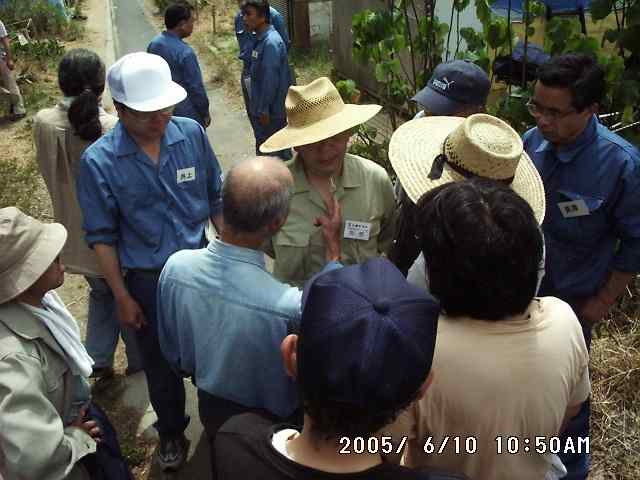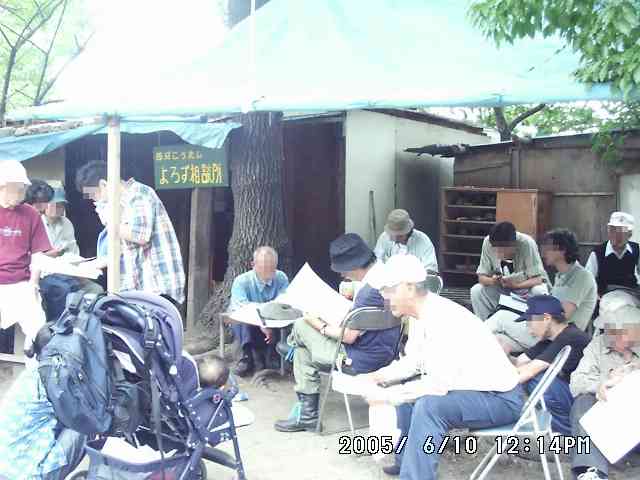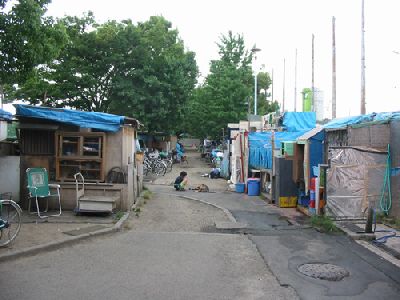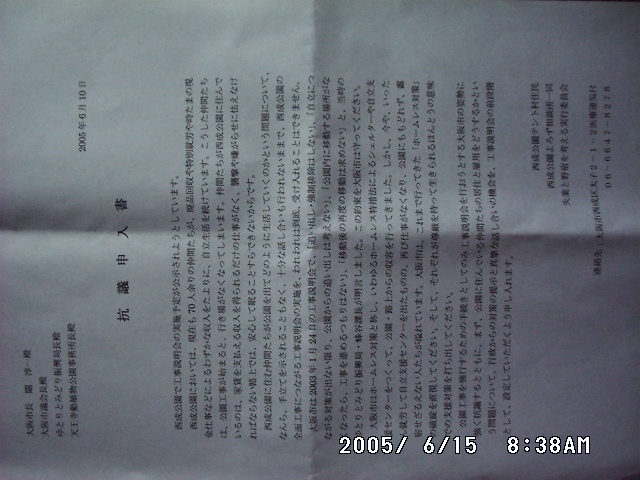From the Open-Publishing Calendar
From the Open-Publishing Newswire
Indybay Feature
Resistance and Refusal in Osaka: on the Self-Managed village at Nishi-Nari Kouen
There is a quiet park on the way to the Osaka ports, still in the city but not near any subway exits, far from the crowds of the Tsuruhashi mall to its east and two blocks away the highway churns past at a dizzying speed.* The park’s name according to the city is Tsumori, but for the workers and unemployed who have dug themselves into its contours, it’s known as Nishi-Nari.

---Resistance and Refusal in Osaka: on the Self-Managed village at Nishi-Nari Kouen---
There is a quiet park on the way to the Osaka ports, still in the city but not near any subway exits, far from the crowds of the Tsuruhashi mall to its east and two blocks away the highway churns past at a dizzying speed.* The park’s name according to the city is Tsumori, but for the workers and unemployed who have dug themselves into its contours, it’s known as Nishi-Nari. Nishi-Nari is also the name of Osaka city’s large southern ward, populated largely by day laborers, home makers, prostitutes and small shopkeepers. The daily activity of these individuals animates the productive grid across the southern belt: quarries, factories, docks, kitchens, beds; some day-workers are dispatched to the highways, many to the streets for road-patching or useless ‘traffic direction’. Others will spend their day pushing across the city circuits, scouring for cardboard and other recyclable materials, a cart-load of which will earn one 400 yen (less than four dollars). The ward is widely known as a slum, its mention in north Osaka will get you a raised eyebrow at the least; its inhabitants come from a wide-range of backgrounds, a wide range of life-long poverties; it is not rare to find an ex-con veteran of the 1960s and 1970s direct action movements, blacklisted or thrown out of his or her family onto the streets of Nishi-Nari. Nishi-Nari acts in this way as a repository for those at the very lowest strata of Japanese society, and for this reason it is historically quite radical. Riots roared through the streets twice in the 1990s in response to police brutality, for nearly a week the streets were uncontrollable, local motorcycle ‘speed tribes’ joined in the activity, showing up with cacophonous engines growling. Organizationally, most of the spontaneous activity that takes place in Nishi-Nari takes place outside unions, though things do occasionally climax with the local ‘worker’s union’ stepping in. Nishi-Nari is thus a wide swathe of inter-connections stretching east and west. It is in this sense that ‘Tsumori’ park, located west of Nishi-Nari, came to be known as Nishi-Nari park. And that's where this story begins.
When you arrive at Nishi-Nari park you’ll come across the impromptu welcome center, a simple table under a tent, usually with a few people seated in discussion or just enjoying themselves. The occupied section of the park extends in both directions from this welcome center, curving to make a circle around a large baseball diamond as well as a massive vacant lot where the state made a year-long effort to install a ‘shelter’ in 2002 (more on this below). People live on ordered lots, with much more space than the average prole has between themselves and their neighbors in an apartment building. Most have a blue tarp pulled over top to ward off the rain, many somehow have electricity and quite a few houses are elaborated with decoration. A metal fan spins in the quiet mid-day wind, drying clothes flap, dogs lope by at a pace that doesn’t seem to heed the clock hand. On the south side of the park is one particularly impressive poly-level garden brought to life by a resident, featuring grapes hanging over tomatoes and lettuce. He's humble and doesn’t see what the big deal is. Flower gardens are scattered here and there.
What exists at Nishi-Nari Park is a quasi-autonomy: a refusal of capitalist housing. These aging workers, many at the lowest end of Japanese society, choose instead of monthly rent payments, a policed neighborhood or even a ‘worker’s hotel’ (which charge the equivalent in yen of 20 dollars a night), the ability to choose for themselves, a ground where their collective powers can meet without the mediating gaze of the state. It was on these lines that a struggle developed within the park in 2003.
----The only homeless are the suckers paying rent----
Many visitors to Japan are usually shocked by the dignified housing of the homeless, who manage to live in city streets, parks, bridges, rivers etc. in improvised houses, quite well-constructed, many with a post-office box. Though this limited affluence isn’t the case for everyone, the prevalence of the phenomenon is a product of consistent conflict within Japanese society. However, despite such a relative autonomy, certain advantages accrue to mayors and city management; ultimately the very poorest workers are submitted to the whim of policy, in other words the will of the state. The most vulnerable modes of subsistence are declared illegal and subjected to the worst of capital’s discipline. Against this tendency, those whose means of existence are deemed ‘illegal’ gather together (or they are chased) and tent villages are formed. These are some of the networks making up the backbone of the entire Nishi-Nari ward; the comrades in Nishi-Nari park being one concentration of this tendency.
Though the Japanese state has been forced to accept much of this resistance, largely because it its own processes make such a state of hyper-exploitation inevitable, it seeks more control over the homeless population of the city through means alternately persuasive and violent. The persuasive means are known as the ‘assistance menu’, a selection of health services that are offered by Osaka city to anyone without a fixed address. The ‘menu’ promises very little outside of the standard services already offered by the city, including some free healthcare and ‘advising’. What the ‘menu’ actually does is bring the state and its ‘observers’ into the tent villages for medical check-ups, above all the menu establishes a precedence for surveillance. The residents of Nishi-Nari are very familiar with the case of Osaka Castle Park, where after the state introduced the ‘menu’ it quickly moved to an aggressive eviction plan, pushing hundreds of homeless, unemployed and precarious workers into the park's newly constructed ‘shelter’. Unsurprisingly, the multitude of concerned NGOs lined up right behind the city, hustling the once-autonomous into a dependence-based, state-monitored enclosure. In this sense, we must consider the nature of the city’s ‘shelters’ and their wider implications.
In 2002, Osaka city began construction of a massive ‘shelter’ in the middle of Nishi-Nari Park. Fences were erected around the building, residents of the park found themselves split apart by the massive new monolith. Once again, the NGOs (known as NPOs in Japan) around Nishi-Nari ward came out in favor of the shelter, enthused by the promises of basic welfare, as well as increased concentration of their ‘clients’ in one location and their own seat at the state’s table. And yet the processes this time did not go smoothly, the hustle was interrupted. As soon as construction had completed on the shelter, people got a taste of its ‘accommodations’ and realized that its presence meant eventual destruction of the relative autonomy of the tent village outside. People began to get together and joined an already vocal minority who had opposed the shelter from the outset. Within weeks the opposition had grown to include most of those staying inside the shelter who complained that it had bugs, that everyone was separated, that one could not stay with one’s friends, that one was surveilled and entered into a ‘logbook’ upon exit and entry, the shelter’s ‘curfew’ was despised. Banners were unfurled, flyers passed out all over the ward. By December of 2003, the movement had swelled to the point that the tent village’s ‘reception center’ was now located defiantly on the steps of the shelter, with a giant sign reading ‘SHELTER HANTAI’ (AGAINST THE SHELTER). The state had lost. The shelter’s reputation spread throughout the ward and people grew even more cynical towards the state’s assertive promises. At the end of 2003, the state promised to the residents of the park that they would not be evicted from the park, and that its intrusions were only in the interest of public health. In February 2004, the massive two-story shelter building so heralded by NGOs and the city was unceremoniously torn down. In its place now lies a large, fenced-in sandlot.
----Challenges of the current struggle----
Despite the promise extracted by the state last year, the inhabitants of the park are still hovering in a precarious situation. Recent efforts by the state to penetrate the park and bring in the ‘assistance menu’ are viewed with skepticism by the park’s inhabitants, some want (and need) the care, others refuse it. At the same time, the park has been carved up, fences erected in its interior, and a city hall branch office literally placed in a trailer on its outskirts! One particular section of the park has been squared and fenced off, allegedly for the sake of the neighborhood children. This section is only enterable in the afternoon, and it is locked at night. It was a surprise for city management when kids were found cutting the fence away so that they could play at the park any time they want. In a certain sense then, the Nishi-Nari park residents find natural allies. And yet things are not so simple.
The community around the park is by no means an affluent suburb; mostly it is inhabited by families just making ends meet. They're out at the park often, watching their kids play baseball on the diamonds, watching coaches discipline their children with growling bellows. People here generally don't like the park’s ‘homeless’, many desire the eviction of the tent community so that the post-war capitalist promise of the house, the park, the school and the family can come true without intrusions by any contradictions that such a dream produces. Accordingly, the tent villagers have an often challenging relation with the community around them. This is doubled by the state, which amplifies the complaints of the ‘normalized’ neighborhood residents to the level of unanimous condemnation and rules more or less openly that, by virtue of democracy, the tent village is a ‘nuisance’ and its days numbered.
In May, alongside increasing initiatives to register park residents for its ‘assistance menu’ the state announced a ‘complete reconstruction’ of the park, emphasis on the construction. ‘Explanation meetings’ were also unilaterally scheduled, mediated by the NGOs, in which the ‘options’ of the tent villagers could be ‘discussed’, when in fact the intention of the meetings is to portray and enforce the ‘futility’ of putting up a fight. The premises are contained very beautifully in the state’s propaganda. It is giving an ‘explanation meeting’ and it wants to hear your ‘opinion’. Never has the word ‘opinion’ ever rung so demonstrably hollow. Our opinions are the tears before the beating. Villagers understood the implications of this sequence, they knew that a similar approach had been taken towards those living in Osaka Castle’s park, and that the city’s future for them is eviction. It is in this setting that the latest initiatives to save the park are underway. Circulars have been making the round across the ward asking for people to move to the park in order to prevent eviction, sympathetic people are asked to come to the park during the state's ‘Explanation meetings’ in order to confront the ‘explainers’ and drive them out of the park. We are looking for people to expand this struggle most of all, in creative ways. Endorsements by labor unions and other organizations are also sought.
On the 10th of June the inhabitants of the park tried to deliver a statement of their position to the city and were flatly refused by the machine-like administration for whom everything is already ‘decided’. And yet, life will not fit into ‘fate’ for those who refuse its prescriptions. With help we can defeat the city’s attempt to destroy this place.
The Japanese government is particularly humiliated when confronted with its own policies from abroad. Therefore, we are asking people who can’t participate on the ground to help us out with international faxes to the following institutions that are currently launching an offensive against the tent village at Nishi-Nari park.
The following are the phone numbers of those individuals and institutions responsible:
(http://www.city.osaka.jp/english/osaka_world/ock007r.html)
-------------------------
Osaka Prefectural Government in San Francisco
Location 345 California St., #2575, San Francisco, CA 94104
Contact Tel : 415-288-3920, Fax : 415-288-3924
-------------------------
Mayor’s office
Secretary
530-8201
Osaka-shi Kita-ku Naka-o-shima1-3-20
Tel 06-6208-7231
Fax 06-6202-6950
-------------------------
Tennoji Parks office
Parks office
TEL:06-6771-2740FAX:06-6772-4633
543-0063
Tennoji Cha Usuyama-cho 1-108 (Tennoji Kouen-nai)
Director’s office
06-6771-8401
------------------------
Osaka City Yutori Midori Promotions Dept.
TEL06-6615-0614 FAX06-6615-0659
Osaka City Suminoe-ku Minato Kita 1-14-16
Osaka World Trade Center Building
WTC Cosmo Tower
28th floor General offices
17th floor Tree planting Dept.
------------------------------
SINGAPORE
City of Osaka, Singapore Office
5 Shenton Way
#37-01 UIC Building
Singapore 068808
Republic of Singapore
Tel: (65)6220-8588
Fax: (65)6224-9980
osaka (at) singnet.com.sg
PARIS
Bureau de Representation
de la Ville d'Osaka a Paris
29, rue des Pyramides
75001 Paris
France
Tel: 33-(1)4015-9366
Fax: 33-(1)4015-9172
ocparis (at) netntt.fr
SHANGHAI
City of Osaka, Shanghai Office
Room 407, Shanghai International
Trade Center
2200 Yan An Road West
Shanghai, China
Tel: 86-(21)6275-1982
Fax: 86-(21)6275-1983
webmaster (at) osakacity-sh.com
CHICAGO
City of Osaka, Chicago Office
c/o JETRO Chicago
401 North Michigan Avenue, Suite 660
Chicago, Illinois
60611 USA
Tel: 1-(312)832-6002
Fax: 1-(312)832-6066
DUSSELDORF
City of Osaka, Dusseldorf Office
c/o JETRO Dusseldorf
Konigsallee 58
40212 Dusseldorf
Germany
Tel: 49-(211)1360241
Fax: 49-(211)326411
----People wishing to get involved can contact nishinarirentai (at) yahoo.com----
*A tent village has been here in the park since the early 1990s. Residents have successfully resisted eviction several times since its occupation.
(More pictures and updates to come, Japanese versions on the way. Attached is a statement of demands that the residents of the park are making to the city which the city is refusing to look at. Faxing to the above numbers would help the current struggle quite a bit, as well as other creative actions.)
There is a quiet park on the way to the Osaka ports, still in the city but not near any subway exits, far from the crowds of the Tsuruhashi mall to its east and two blocks away the highway churns past at a dizzying speed.* The park’s name according to the city is Tsumori, but for the workers and unemployed who have dug themselves into its contours, it’s known as Nishi-Nari. Nishi-Nari is also the name of Osaka city’s large southern ward, populated largely by day laborers, home makers, prostitutes and small shopkeepers. The daily activity of these individuals animates the productive grid across the southern belt: quarries, factories, docks, kitchens, beds; some day-workers are dispatched to the highways, many to the streets for road-patching or useless ‘traffic direction’. Others will spend their day pushing across the city circuits, scouring for cardboard and other recyclable materials, a cart-load of which will earn one 400 yen (less than four dollars). The ward is widely known as a slum, its mention in north Osaka will get you a raised eyebrow at the least; its inhabitants come from a wide-range of backgrounds, a wide range of life-long poverties; it is not rare to find an ex-con veteran of the 1960s and 1970s direct action movements, blacklisted or thrown out of his or her family onto the streets of Nishi-Nari. Nishi-Nari acts in this way as a repository for those at the very lowest strata of Japanese society, and for this reason it is historically quite radical. Riots roared through the streets twice in the 1990s in response to police brutality, for nearly a week the streets were uncontrollable, local motorcycle ‘speed tribes’ joined in the activity, showing up with cacophonous engines growling. Organizationally, most of the spontaneous activity that takes place in Nishi-Nari takes place outside unions, though things do occasionally climax with the local ‘worker’s union’ stepping in. Nishi-Nari is thus a wide swathe of inter-connections stretching east and west. It is in this sense that ‘Tsumori’ park, located west of Nishi-Nari, came to be known as Nishi-Nari park. And that's where this story begins.
When you arrive at Nishi-Nari park you’ll come across the impromptu welcome center, a simple table under a tent, usually with a few people seated in discussion or just enjoying themselves. The occupied section of the park extends in both directions from this welcome center, curving to make a circle around a large baseball diamond as well as a massive vacant lot where the state made a year-long effort to install a ‘shelter’ in 2002 (more on this below). People live on ordered lots, with much more space than the average prole has between themselves and their neighbors in an apartment building. Most have a blue tarp pulled over top to ward off the rain, many somehow have electricity and quite a few houses are elaborated with decoration. A metal fan spins in the quiet mid-day wind, drying clothes flap, dogs lope by at a pace that doesn’t seem to heed the clock hand. On the south side of the park is one particularly impressive poly-level garden brought to life by a resident, featuring grapes hanging over tomatoes and lettuce. He's humble and doesn’t see what the big deal is. Flower gardens are scattered here and there.
What exists at Nishi-Nari Park is a quasi-autonomy: a refusal of capitalist housing. These aging workers, many at the lowest end of Japanese society, choose instead of monthly rent payments, a policed neighborhood or even a ‘worker’s hotel’ (which charge the equivalent in yen of 20 dollars a night), the ability to choose for themselves, a ground where their collective powers can meet without the mediating gaze of the state. It was on these lines that a struggle developed within the park in 2003.
----The only homeless are the suckers paying rent----
Many visitors to Japan are usually shocked by the dignified housing of the homeless, who manage to live in city streets, parks, bridges, rivers etc. in improvised houses, quite well-constructed, many with a post-office box. Though this limited affluence isn’t the case for everyone, the prevalence of the phenomenon is a product of consistent conflict within Japanese society. However, despite such a relative autonomy, certain advantages accrue to mayors and city management; ultimately the very poorest workers are submitted to the whim of policy, in other words the will of the state. The most vulnerable modes of subsistence are declared illegal and subjected to the worst of capital’s discipline. Against this tendency, those whose means of existence are deemed ‘illegal’ gather together (or they are chased) and tent villages are formed. These are some of the networks making up the backbone of the entire Nishi-Nari ward; the comrades in Nishi-Nari park being one concentration of this tendency.
Though the Japanese state has been forced to accept much of this resistance, largely because it its own processes make such a state of hyper-exploitation inevitable, it seeks more control over the homeless population of the city through means alternately persuasive and violent. The persuasive means are known as the ‘assistance menu’, a selection of health services that are offered by Osaka city to anyone without a fixed address. The ‘menu’ promises very little outside of the standard services already offered by the city, including some free healthcare and ‘advising’. What the ‘menu’ actually does is bring the state and its ‘observers’ into the tent villages for medical check-ups, above all the menu establishes a precedence for surveillance. The residents of Nishi-Nari are very familiar with the case of Osaka Castle Park, where after the state introduced the ‘menu’ it quickly moved to an aggressive eviction plan, pushing hundreds of homeless, unemployed and precarious workers into the park's newly constructed ‘shelter’. Unsurprisingly, the multitude of concerned NGOs lined up right behind the city, hustling the once-autonomous into a dependence-based, state-monitored enclosure. In this sense, we must consider the nature of the city’s ‘shelters’ and their wider implications.
In 2002, Osaka city began construction of a massive ‘shelter’ in the middle of Nishi-Nari Park. Fences were erected around the building, residents of the park found themselves split apart by the massive new monolith. Once again, the NGOs (known as NPOs in Japan) around Nishi-Nari ward came out in favor of the shelter, enthused by the promises of basic welfare, as well as increased concentration of their ‘clients’ in one location and their own seat at the state’s table. And yet the processes this time did not go smoothly, the hustle was interrupted. As soon as construction had completed on the shelter, people got a taste of its ‘accommodations’ and realized that its presence meant eventual destruction of the relative autonomy of the tent village outside. People began to get together and joined an already vocal minority who had opposed the shelter from the outset. Within weeks the opposition had grown to include most of those staying inside the shelter who complained that it had bugs, that everyone was separated, that one could not stay with one’s friends, that one was surveilled and entered into a ‘logbook’ upon exit and entry, the shelter’s ‘curfew’ was despised. Banners were unfurled, flyers passed out all over the ward. By December of 2003, the movement had swelled to the point that the tent village’s ‘reception center’ was now located defiantly on the steps of the shelter, with a giant sign reading ‘SHELTER HANTAI’ (AGAINST THE SHELTER). The state had lost. The shelter’s reputation spread throughout the ward and people grew even more cynical towards the state’s assertive promises. At the end of 2003, the state promised to the residents of the park that they would not be evicted from the park, and that its intrusions were only in the interest of public health. In February 2004, the massive two-story shelter building so heralded by NGOs and the city was unceremoniously torn down. In its place now lies a large, fenced-in sandlot.
----Challenges of the current struggle----
Despite the promise extracted by the state last year, the inhabitants of the park are still hovering in a precarious situation. Recent efforts by the state to penetrate the park and bring in the ‘assistance menu’ are viewed with skepticism by the park’s inhabitants, some want (and need) the care, others refuse it. At the same time, the park has been carved up, fences erected in its interior, and a city hall branch office literally placed in a trailer on its outskirts! One particular section of the park has been squared and fenced off, allegedly for the sake of the neighborhood children. This section is only enterable in the afternoon, and it is locked at night. It was a surprise for city management when kids were found cutting the fence away so that they could play at the park any time they want. In a certain sense then, the Nishi-Nari park residents find natural allies. And yet things are not so simple.
The community around the park is by no means an affluent suburb; mostly it is inhabited by families just making ends meet. They're out at the park often, watching their kids play baseball on the diamonds, watching coaches discipline their children with growling bellows. People here generally don't like the park’s ‘homeless’, many desire the eviction of the tent community so that the post-war capitalist promise of the house, the park, the school and the family can come true without intrusions by any contradictions that such a dream produces. Accordingly, the tent villagers have an often challenging relation with the community around them. This is doubled by the state, which amplifies the complaints of the ‘normalized’ neighborhood residents to the level of unanimous condemnation and rules more or less openly that, by virtue of democracy, the tent village is a ‘nuisance’ and its days numbered.
In May, alongside increasing initiatives to register park residents for its ‘assistance menu’ the state announced a ‘complete reconstruction’ of the park, emphasis on the construction. ‘Explanation meetings’ were also unilaterally scheduled, mediated by the NGOs, in which the ‘options’ of the tent villagers could be ‘discussed’, when in fact the intention of the meetings is to portray and enforce the ‘futility’ of putting up a fight. The premises are contained very beautifully in the state’s propaganda. It is giving an ‘explanation meeting’ and it wants to hear your ‘opinion’. Never has the word ‘opinion’ ever rung so demonstrably hollow. Our opinions are the tears before the beating. Villagers understood the implications of this sequence, they knew that a similar approach had been taken towards those living in Osaka Castle’s park, and that the city’s future for them is eviction. It is in this setting that the latest initiatives to save the park are underway. Circulars have been making the round across the ward asking for people to move to the park in order to prevent eviction, sympathetic people are asked to come to the park during the state's ‘Explanation meetings’ in order to confront the ‘explainers’ and drive them out of the park. We are looking for people to expand this struggle most of all, in creative ways. Endorsements by labor unions and other organizations are also sought.
On the 10th of June the inhabitants of the park tried to deliver a statement of their position to the city and were flatly refused by the machine-like administration for whom everything is already ‘decided’. And yet, life will not fit into ‘fate’ for those who refuse its prescriptions. With help we can defeat the city’s attempt to destroy this place.
The Japanese government is particularly humiliated when confronted with its own policies from abroad. Therefore, we are asking people who can’t participate on the ground to help us out with international faxes to the following institutions that are currently launching an offensive against the tent village at Nishi-Nari park.
The following are the phone numbers of those individuals and institutions responsible:
(http://www.city.osaka.jp/english/osaka_world/ock007r.html)
-------------------------
Osaka Prefectural Government in San Francisco
Location 345 California St., #2575, San Francisco, CA 94104
Contact Tel : 415-288-3920, Fax : 415-288-3924
-------------------------
Mayor’s office
Secretary
530-8201
Osaka-shi Kita-ku Naka-o-shima1-3-20
Tel 06-6208-7231
Fax 06-6202-6950
-------------------------
Tennoji Parks office
Parks office
TEL:06-6771-2740FAX:06-6772-4633
543-0063
Tennoji Cha Usuyama-cho 1-108 (Tennoji Kouen-nai)
Director’s office
06-6771-8401
------------------------
Osaka City Yutori Midori Promotions Dept.
TEL06-6615-0614 FAX06-6615-0659
Osaka City Suminoe-ku Minato Kita 1-14-16
Osaka World Trade Center Building
WTC Cosmo Tower
28th floor General offices
17th floor Tree planting Dept.
------------------------------
SINGAPORE
City of Osaka, Singapore Office
5 Shenton Way
#37-01 UIC Building
Singapore 068808
Republic of Singapore
Tel: (65)6220-8588
Fax: (65)6224-9980
osaka (at) singnet.com.sg
PARIS
Bureau de Representation
de la Ville d'Osaka a Paris
29, rue des Pyramides
75001 Paris
France
Tel: 33-(1)4015-9366
Fax: 33-(1)4015-9172
ocparis (at) netntt.fr
SHANGHAI
City of Osaka, Shanghai Office
Room 407, Shanghai International
Trade Center
2200 Yan An Road West
Shanghai, China
Tel: 86-(21)6275-1982
Fax: 86-(21)6275-1983
webmaster (at) osakacity-sh.com
CHICAGO
City of Osaka, Chicago Office
c/o JETRO Chicago
401 North Michigan Avenue, Suite 660
Chicago, Illinois
60611 USA
Tel: 1-(312)832-6002
Fax: 1-(312)832-6066
DUSSELDORF
City of Osaka, Dusseldorf Office
c/o JETRO Dusseldorf
Konigsallee 58
40212 Dusseldorf
Germany
Tel: 49-(211)1360241
Fax: 49-(211)326411
----People wishing to get involved can contact nishinarirentai (at) yahoo.com----
*A tent village has been here in the park since the early 1990s. Residents have successfully resisted eviction several times since its occupation.
(More pictures and updates to come, Japanese versions on the way. Attached is a statement of demands that the residents of the park are making to the city which the city is refusing to look at. Faxing to the above numbers would help the current struggle quite a bit, as well as other creative actions.)





Add Your Comments
Latest Comments
Listed below are the latest comments about this post.
These comments are submitted anonymously by website visitors.
TITLE
AUTHOR
DATE
Re:protestletter.jpg, image/jpeg, 640x480
Sun, Jul 3, 2005 8:23PM
We are 100% volunteer and depend on your participation to sustain our efforts!
Get Involved
If you'd like to help with maintaining or developing the website, contact us.
Publish
Publish your stories and upcoming events on Indybay.
Topics
More
Search Indybay's Archives
Advanced Search
►
▼
IMC Network


